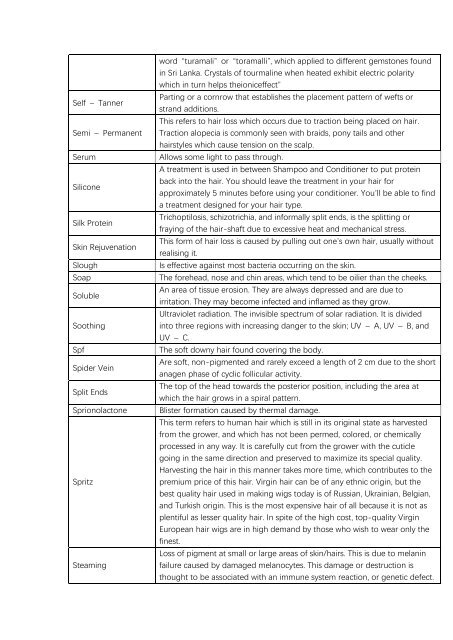Hair & Beauty Glossary
A hair & beauty glossary that provides you with all the common hair & beauty terms and their definitions.
A hair & beauty glossary that provides you with all the common hair & beauty terms and their definitions.
Create successful ePaper yourself
Turn your PDF publications into a flip-book with our unique Google optimized e-Paper software.
Self – Tanner<br />
Semi – Permanent<br />
Serum<br />
Silicone<br />
Silk Protein<br />
Skin Rejuvenation<br />
Slough<br />
Soap<br />
Soluble<br />
Soothing<br />
Spf<br />
Spider Vein<br />
Split Ends<br />
Sprionolactone<br />
Spritz<br />
Steaming<br />
word “turamali” or “toramalli”, which applied to different gemstones found<br />
in Sri Lanka. Crystals of tourmaline when heated exhibit electric polarity<br />
which in turn helps theioniceffect”<br />
Parting or a cornrow that establishes the placement pattern of wefts or<br />
strand additions.<br />
This refers to hair loss which occurs due to traction being placed on hair.<br />
Traction alopecia is commonly seen with braids, pony tails and other<br />
hairstyles which cause tension on the scalp.<br />
Allows some light to pass through.<br />
A treatment is used in between Shampoo and Conditioner to put protein<br />
back into the hair. You should leave the treatment in your hair for<br />
approximately 5 minutes before using your conditioner. You’ll be able to find<br />
a treatment designed for your hair type.<br />
Trichoptilosis, schizotrichia, and informally split ends, is the splitting or<br />
fraying of the hair-shaft due to excessive heat and mechanical stress.<br />
This form of hair loss is caused by pulling out one’s own hair, usually without<br />
realising it.<br />
Is effective against most bacteria occurring on the skin.<br />
The forehead, nose and chin areas, which tend to be oilier than the cheeks.<br />
An area of tissue erosion. They are always depressed and are due to<br />
irritation. They may become infected and inflamed as they grow.<br />
Ultraviolet radiation. The invisible spectrum of solar radiation. It is divided<br />
into three regions with increasing danger to the skin; UV – A, UV – B, and<br />
UV – C.<br />
The soft downy hair found covering the body.<br />
Are soft, non-pigmented and rarely exceed a length of 2 cm due to the short<br />
anagen phase of cyclic follicular activity.<br />
The top of the head towards the posterior position, including the area at<br />
which the hair grows in a spiral pattern.<br />
Blister formation caused by thermal damage.<br />
This term refers to human hair which is still in its original state as harvested<br />
from the grower, and which has not been permed, colored, or chemically<br />
processed in any way. It is carefully cut from the grower with the cuticle<br />
going in the same direction and preserved to maximize its special quality.<br />
Harvesting the hair in this manner takes more time, which contributes to the<br />
premium price of this hair. Virgin hair can be of any ethnic origin, but the<br />
best quality hair used in making wigs today is of Russian, Ukrainian, Belgian,<br />
and Turkish origin. This is the most expensive hair of all because it is not as<br />
plentiful as lesser quality hair. In spite of the high cost, top-quality Virgin<br />
European hair wigs are in high demand by those who wish to wear only the<br />
finest.<br />
Loss of pigment at small or large areas of skin/hairs. This is due to melanin<br />
failure caused by damaged melanocytes. This damage or destruction is<br />
thought to be associated with an immune system reaction, or genetic defect.



